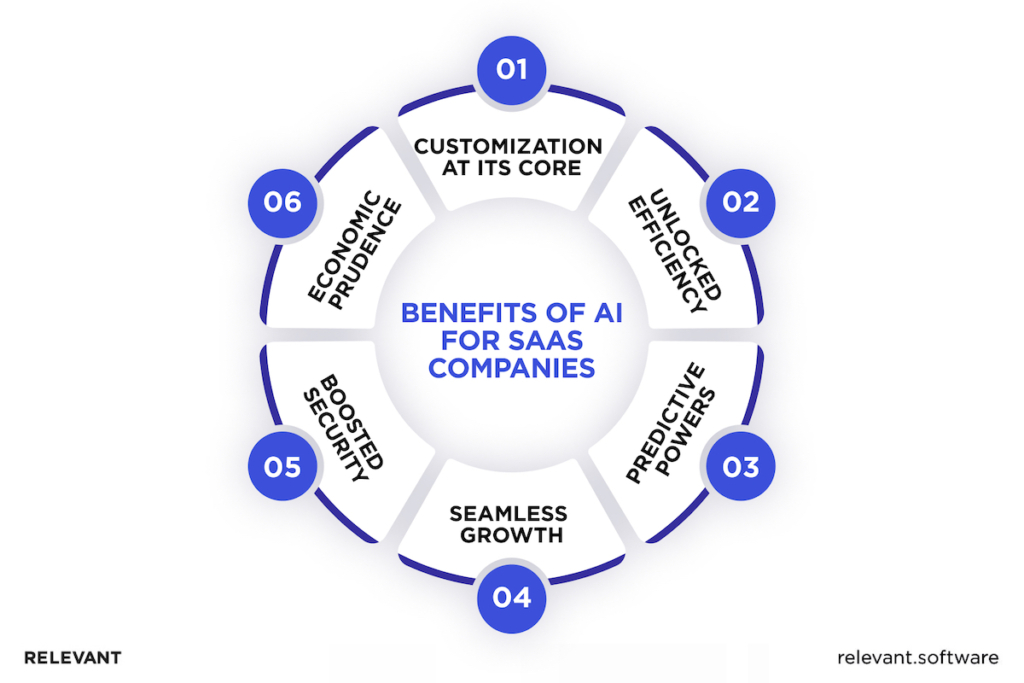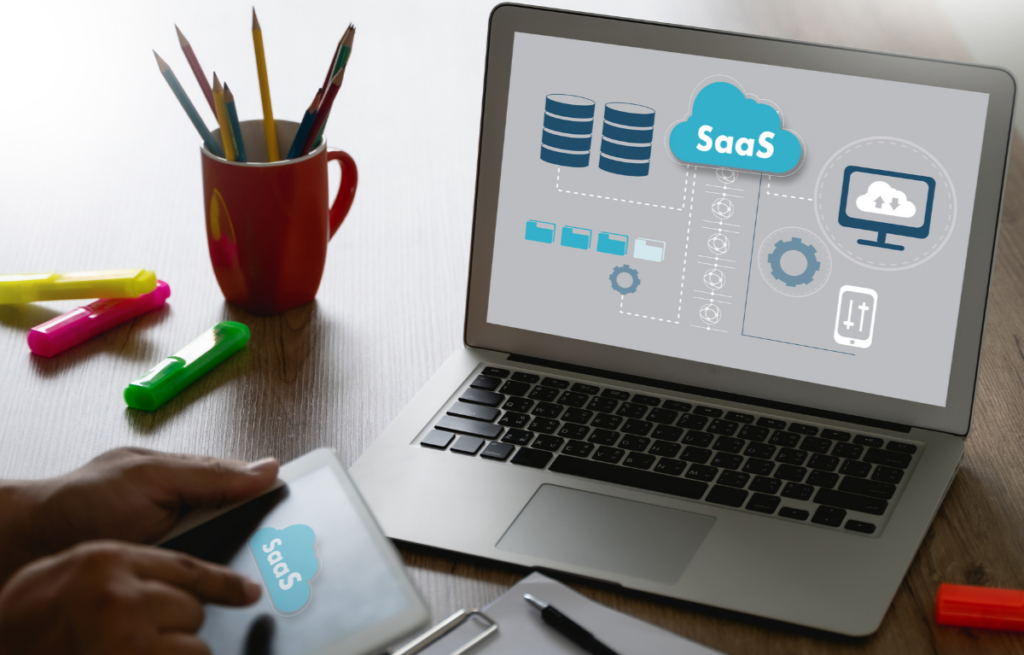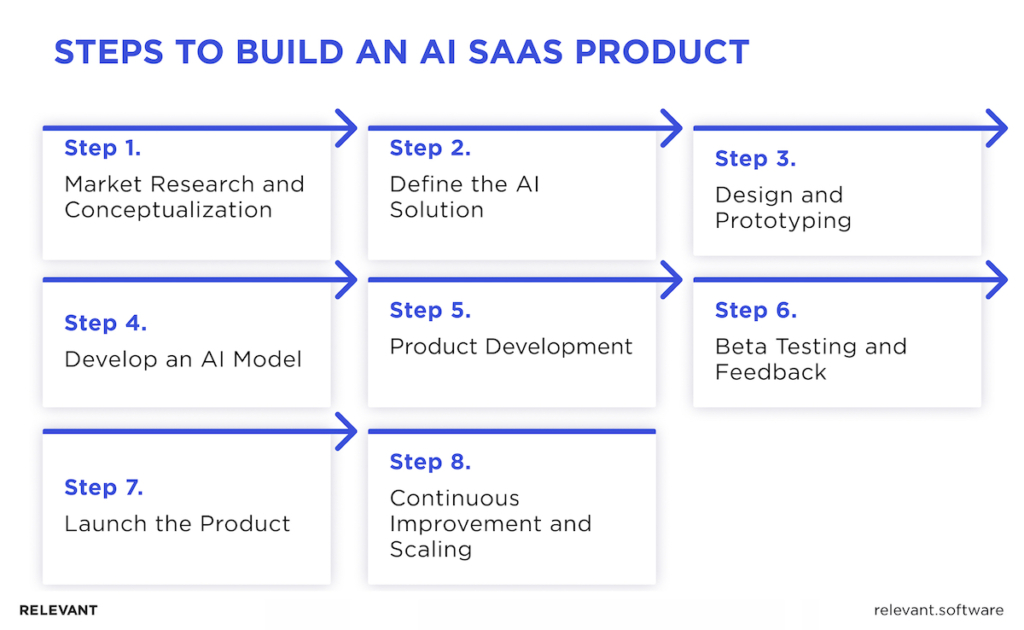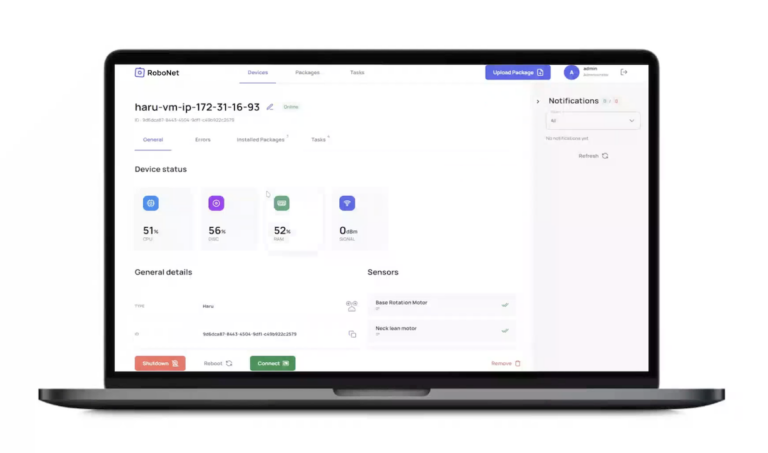AI SaaS: Speculating on The Future for SaaS Providers
Before diving into how AI complements the Software-as-a-Service world and walking you through creating an AI SaaS product, let’s glance at the SaaS market. In 2024, it’s ballooning to $232 billion! A peek into a Statista report reveals about 9,100 SaaS ventures in the U.S. alone that will cater to 15 billion customers this year. Not to be outdone, the UK ranks second with 1,500 companies serving 293 million users worldwide.
But what’s the deal with AI in such a huge market? According to a SaaS Academy, 35% of SaaS companies are already using AI, and another 42% are planning to incorporate it soon. This is because AI integration into SaaS products transforms them from static, one-size-fits-all solutions into intelligent platforms capable of learning and adapting to the unique demands of their users.
200+ companies from 25 countries outsourced software development to Relevant
We provide companies with senior tech talent and product development expertise to build world-class software. Let's talk about how we can help you.
Contact usAnd you mustn’t be left behind! See the difference AI is making in the SaaS environment and follow our step-by-step guide to implement AI into SaaS software.
Table of Contents
AI and SaaS: A Strategic Alliance to Transform Industries
SaaS AI convergence feels like nearing the future where technology truly understands and responds to our needs, laying down the criteria for what it means to be efficient.
AI is like having a brainy companion who can sift through mountains of data and help make smart choices that used to be shots in the dark. It’s making everything from customer service (think smarter chatbots) to operational efficiency (like forecasting what’s needed) better and more innovative. On the flip side, Software as a Service (SaaS) reorganizes software delivery. With its internet-based subscription model, it eradicates the traditional hassles of on-site software setups.
Put AI and SaaS together, and you get something special. It means SaaS platforms can now deliver services that are not just efficient and scalable but also highly personalized and intelligent, capable of evolving in real time to meet user demands.
Here’s a table outlining the key aspects of what is SaaS AI:
| Aspect | AI | SaaS | AI SaaS |
| Definition | Technology that simulates human intelligence processes by machines. | A service model for distributing software, where the provider hosts applications that users can access online. | Combines AI technologies with SaaS delivery models to offer intelligent, scalable solutions. |
| Primary Use | Machine learning models, natural language processing, robotics. | Cloud-based applications for business management, CRM, ERP. | Enhanced business applications with embedded AI for smarter operations. |
| Benefits | Automation of tasks, enhanced decision-making, predictive analytics. | Cost efficiency, scalability, accessibility, automatic updates. | Leverages AI to bring smart automation, deep insights, and personalization to SaaS platforms. |
| Challenges | Data privacy concerns, high initial investment, complexity in implementation. | Data security, internet dependency, limited customization. | Complexity in integration, ensuring AI ethics and security within SaaS environments. |
| Future Trends | Advancements in quantum computing, ethical AI, broader adoption across industries. | Increased integration capabilities, focus on security, AI-driven functionalities. | Expansion of AI capabilities within SaaS, growing emphasis on ethical AI, and seamless integration. |
Ways SaaS Companies Benefit from AI
AI SaaS synergy boosts the user experience and equips businesses with advanced tools for data analysis, trend prediction, and task automation. Let’s look at the ways AI is turbocharging SaaS applications:

- Customization at Its Core
AI harnesses the vast sea of user data to sculpt experiences that resonate on a personal level. In the domain of SaaS, especially within marketing automation, this ability to craft messages that speak directly to the user’s preferences can markedly elevate engagement and, consequently, conversion rates.
- Unlocked Effectiveness
AI’s role in automating routine activity—such as data compilation and report generation—liberates human intellect to pursue broader strategic visions. This attribute is particularly invaluable in project management applications, where the essence of efficiency lies in the smooth orchestration of tasks and resources.
- Predictive Powers
Through meticulous analysis of extensive datasets, AI SaaS unveils patterns and forecasts future behaviors. In customer relationship management systems, this foresight translates into identifying burgeoning sales leads and fortifying customer loyalty, thereby guaranteeing sustained business growth.
- Seamless Growth
AI facilitates the scalable growth of SaaS platforms, automating complex processes and diminishing the reliance on manual oversight—essential for managing vast data or intricate workflows without compromising on agility or precision.
- Boosted Security
With the SaaS sector booming recently, more people than ever are using these platforms. Strengthening your SaaS software’s security is a must, and blending AI with SaaS to spot malware can create a fortress around your solution.
- Economic Prudence
The economization of resources, a byproduct of AI’s automation and efficiency capabilities, extends a lifeline to businesses aiming to optimize operational costs without sacrificing quality or innovation.

Popular SaaS Products with AI Capabilities
AI boosts SaaS solutions by adding more advanced features, helping users do more with them. Take Grammarly, for instance – it uses AI to spot grammar mistakes and suggest fixes. Here are other examples where AI seamlessly integrates with SaaS.
Customer Relationship Management (CRM) with AI
Modern SaaS AI CRMs actively employ smart automation and predictive analytics. These platforms leverage AI to sift through data, offering insights that help businesses tailor their approaches to meet customer needs more effectively and streamline operations. Among them:
- Salesforce Einstein: Adds AI to Salesforce for predictive insights and task automation.
- HubSpot CRM: Uses AI for streamlining sales and enhancing customer service.
- Zoho CRM: Employs AI for alerts, predictive analytics, and process automation.
- Pipedrive AI: Focuses on sales automation, lead scoring, and deal prediction.
AI SaaS Visualization Tools
AI SaaS companies are increasingly leveraging ChatGPT for visualizing data. Yet, venturing beyond ChatGPT’s NLP capabilities reveals a rich landscape of SaaS AI tools designed specifically for data visualization:
- Storydoc: Helps create engaging and interactive business presentations and reports with AI.
- Luzmo: Leverage AI to develop and incorporate dashboards into any software, boosting customer decision-making capabilities.
- Generative BI: Pose a question and automatically generate insightful dashboards.
- Tableau: A stalwart in business intelligence that integrates AI for predictive analytics and forecasting across diverse data sets.
AI Analytics for SaaS Companies
AI SaaS companies are pushing the envelope beyond mere data visualization, using the possibilities of text analysis, forecasting, and data science with the help of artificial intelligence.
- Akkio: Specializes in enhancing forecasting and optimization through AI, leading to more precise predictions.
- MonkeyLearn: Stands out in large-scale text analysis, transforming extensive text data into actionable insights.
- AI Excel Bot: Streamlines handling complex Excel formulas, significantly saving time.
- AIHelperBot: Provides an AI SaaS platform that automatically generates SQL queries, simplifying database interactions.
AI Chatbots for SaaS
AI chatbots for SaaS platforms are altering customer service and engagement by offering instant, 24/7 support and personalized user interactions. Here are four notable examples:
- Intercom: Enhances customer conversations with AI, directing questions to the appropriate team and offering immediate, knowledge-based answers.
- Drift: Uses AI for conversational marketing and sales, helping qualify leads, schedule meetings, and give personalized advice to boost sales.
- Zendesk Chat: Employs AI for smart, automated support, analyzing inquiries to quickly resolve issues or escalate them when necessary.
- Freshchat: Leverages AI for predictive engagement, proactively starting conversations based on user behavior to enhance satisfaction and conversions.
Steps to Build an AI SaaS Product
Creating an AI-powered Software as a Service (SaaS) product combines smart technology with innovative development. Follow these key steps to transition your AI SaaS concept into a fully scalable and operational product.

Step 1: Market Research and Conceptualization
Begin by diving deep into market research to understand the needs, challenges, and gaps in your target market. This initial exploration should aim to uncover a viable niche where AI can offer significant value. Following this, conceptualize your product by outlining the problem it solves, the target audience, and how AI integration differentiates it from existing solutions. This phase sets the foundation for your product’s direction and goals.
Step 2: Define the AI Solution
Once the groundwork is laid, the next step is to define the AI solution. This involves specifying the AI technologies and methodologies that will be used to address the identified problems. Whether it’s machine learning, natural language processing, or another AI technology, you must outline how AI will function within the broader framework of your SaaS product, including the data it will need and the outcomes you expect.
Step 3: Design and Prototyping
Design and prototyping involve creating the initial versions of your product with a focus on user experience (UX) and user interface (UI) design. This step should produce a prototype that gives stakeholders a tangible sense of how the final product will look and work. It’s also an opportunity to validate the concept with potential users and refine it based on their feedback.
Step 4: Develop an AI Model
This stage is where the theoretical becomes practical. AI model development entails selecting, training, and testing the AI models that will power your SaaS product. Data scientists and AI engineers work to ensure that the models are accurate, efficient, and scalable. This process often involves iterative adjustments and testing to refine the AI’s performance.
Step 5: Product Development
With a working AI model in place, the focus shifts to SaaS product development. This phase integrates the AI functionalities into the full software product, developing the backend and frontend components, databases, and user interfaces. The goal here is to build a stable, secure, and user-friendly AI SaaS platform that seamlessly incorporates advanced features.
Step 6: Beta Testing and Feedback
Before the official launch, your product should undergo rigorous beta testing with a select group of users. This testing phase is crucial for identifying any bugs, usability issues, or areas for improvement. Gathering and analyzing feedback during this stage allows for fine-tuning the product, ensuring it meets user expectations and operates flawlessly.
Step 7: Launch the Product
The launch marks the moment your AI SaaS product goes live and becomes available to the wider market. This step involves not just the technical deployment but also marketing efforts to promote the product, attract users, and establish a presence in the market. A successful launch is well-coordinated, ensuring that support systems are in place for new users.
Step 8: Continuous Improvement and Scaling
The launch is just the beginning. Post-launch, the focus should be on continuous improvement, scaling the product based on user feedback, and evolving market needs. This includes regular updates, adding new features, and refining AI models to enhance performance and user satisfaction. The ability to adapt and grow will define the long-term success of your AI SaaS product.
By following these steps and continuously iterating based on market feedback, you can build a successful AI SaaS product that solves real problems and delivers value to your customers.
Built In-house or Hire an Outsourcing Team
When it comes to developing an AI SaaS product, companies face a critical decision: should they build it in-house, or should they hire AI engineers? Both options have their unique sets of benefits and challenges, making the right choice dependent on various factors such as budget, timeline, expertise, and project complexity.
Building in-house means opting for your existing team’s talents and resources. This approach allows for greater control over the SaaS development process, potentially leading to better integration with existing systems and culture. Yet, it might call for an investment in bringing new talent on board, providing training, and perhaps even stretching your project’s timelines, especially if your team falls short on specialized AI expertise.
Hiring an outsourcing team, on the other hand, offers flexibility and access to a wide pool of global talent specialized in AI and SaaS development. It can be cost-effective, reducing the need for large upfront investments in recruitment and training. Outsourcing can also accelerate your product’s time to market, given the team’s existing expertise. Yet, challenges such as managing remote teams and ensuring clear communication can arise.
Build an AI SaaS Product with Relevant
At Relevant, we fully grasp the difficulties involved in AI SaaS product development. So, we offer a partnership that extends your in-house team’s capabilities with our dedicated expertise. Whether you’re leaning toward building in-house or outsourcing, Relevant provides flexible services to fit your project needs:
1. Expertise on Demand: Access to a diverse team of experts in AI, machine learning SaaS, data science, and software development without the overhead of hiring.
2. Seamless Integration: Our dedicated team works as an extension of yours, ensuring smooth inclusion with your processes, culture, and goals.
3. Scalability and Flexibility: Whether you need to ramp up quickly or adjust your project scope, our model supports dynamic scaling to meet your project’s evolving requirements.
4. Focus on Innovation: With the technical aspects in our capable hands, your in-house team can focus on strategic initiatives, innovation, and core business operations.
At Relevant, we ensure that whichever path you choose, you have the support and expertise needed to bring your vision to life fruitfully. Contact us to start a talk!
Our core services:
Do you want a price estimate for your project?
Do you know that we helped 200+ companies build web/mobile apps and scale dev teams?
Let's talk about your engineering needs.
Write to us











